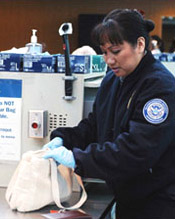TSA Enhances Security With Employee Screening
Layers Of Security
- Click here to read how employee screening is being used in Jacksonville, Florida.

While passengers around the nation are very familiar with the security checkpoint, they may not be as familiar with one of the newest enhancements to aviation security, roving patrols of Transportation Security Officers screening employees on the secure side of the airport.
The program, started last fall, deploys officers anywhere, anytime to inspect workers, their property and vehicles. These officers ensure workers follow proper access procedures when entering secure areas, display the appropriate credentials, and do not possess items unrelated to their work that may pose a security threat.
“Anyone accessing sterile and secure areas of the airport should expect that they could be screened at any time,” said Earl Morris, TSA’s Deputy Assistant Administrator for Security Operations. “This initiative is one more measure that adds to our strong, layered approach to aviation security.”
Outside the airport, random inspections include scrutinizing delivery trucks or personal vehicles at access gates. Inside the airport, roving patrols screen workers with handheld metal detectors and examine property for threat items that are unrelated to their work. Temporary checkpoints are also created beyond access points to ensure access protocols are followed and workers are screened before entering the terminal. These measures do not impact wait times at security checkpoints.
Airport employees receive a security threat assessment prior to receiving credentials and access privileges. Security threat assessments consist of a criminal history records check and vetting against terrorist watch lists and are required for not only airport personnel but also individuals with access to public areas that possess airport credentials. This includes taxi drivers, parking lot attendants, vendors and shuttle bus drivers who have identification issued by the airport.
Airports are also required to develop Airport Security Plans that lay out physical security measures, procedures for safeguarding access control and other protocols specific to the facilities and area around an individual airport.
Individuals who violate security protocols may receive a civil penalty that varies depending on the action and circumstance.


